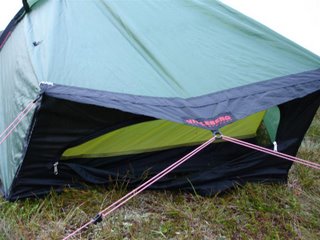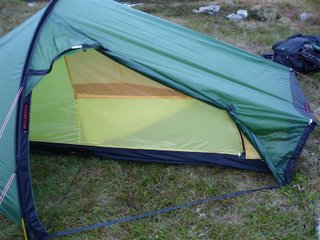The facts about condensation
Condensation is the exact opposite of evaporation. Air inside an occupied tent is warm and humid – which means it has lots of “evaporated” water molecules zipping around in it. That warmer, moister air rises and hits the tent wall (which is cooler because of conductive cooling), and those water vapor molecules slow down and “stick” to the cooler surface: they “condense” out of the air and onto the tent wall. The same thing can happen between your sleeping pad and the floor of the tent.
Hilleberg tents combat this process with:
- Vents situated high up to let warm, moist air out.
- Double wall design with water repellent, breathable inner tent fabric to let vapor pass through, and to keep actual water out.
- More venting via mesh panels in the inner tent doors.
Ventilation

One of the vents is an integral part of the entrance of the outer tent. The degree of venting can easily be adjusted by the size of the opening.

Zipper adjustable vents in head and foot ends of the outer tent provide good air flow, and are protected from rain by the angled design of the end itself.

Also the inner tent has a large vent with no-see-um netting at the entrance which should be kept open whenever possible.
[sources: Hilleberg Akto pitching instructions - 2.42mb file >> download pdf version. Hilleberg Tent Manual - 6.09mb file >> download pdf version]
I tend to use all the vents, only closing one of the outer vents (the one that's into the wind) if the wind and rain are strong.
Unless really cold, I'll keep the 'no-see-um' mesh open. It's midge-proof too. In fact, the only place midges go into the inner was where the 2 zips meet, and that was able to be sealed using microporous tape from the first aid kit.


0 comments:
Post a Comment